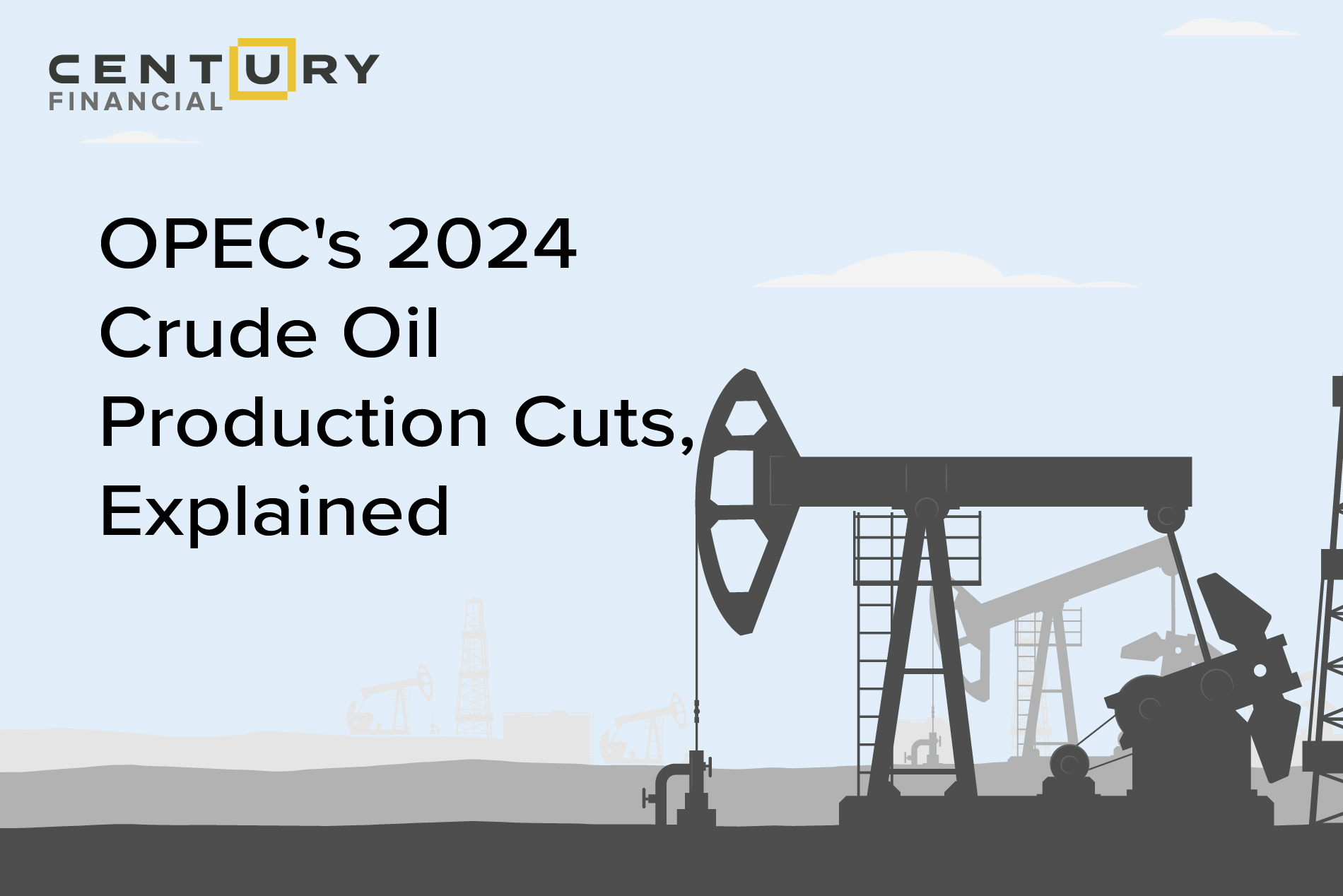Tuesday, July 09, 2024
OPEC's 2024 Crude Oil Production Cuts, Explained
تم إعداد هذا المنشور من قبل سنشري للاستشارات


What is "OPEC+"?
OPEC Organization has a total of 12 Member Countries and accounts for an estimated 30 % of global oil production.
The Organization of the Petroleum Exporting Countries enables the cooperation of leading oil-producing countries to influence the global oil market and maximize profit collectively. It was founded on 14 September 1960 in Baghdad by the first five members (Iran, Iraq, Kuwait, Saudi Arabia, and Venezuela).
The decision
On June 2, the 188th Meeting of the OPEC Conference, the 54th Meeting of the Joint Ministerial Monitoring Committee (JMMC), and the 37th OPEC and non-OPEC Ministerial Meeting (ONOMM) convened to deliberate on the oil market situation and formulate appropriate decisions.
OPEC+ countries have gradually resumed voluntary production cuts as of October 2024. The group-wide supply cuts amount to about two million barrels daily (bpd).
In addition, eight countries—Saudi Arabia, Russia, Iraq, the United Arab Emirates, Kuwait, Kazakhstan, Algeria, and Oman—said they would extend voluntary supply cuts made at Riyadh's request.
The United States produced the most oil in the world in 2022, at around 17.7 million barrels of oil per day on average. Saudi Arabia and Russia followed as the second and third largest producers, and rank amongst the top countries with highest oil exports. The United States was not always the largest producer of oil, but imported oil at higher rates before the 2008 financial crisis. As foreign oil prices peaked during the Recession, investors sought to develop technology to extract more oil domestically, notably through hydraulic fracturing. Since then, oil production in the United States has nearly doubled, reducing the need for imports.
What is the motivation behind these cuts?
The cartel’s goal is to control the price of the precious fossil fuel known as crude oil. As per 2021 figures from the World Economic Forum, OPEC+ controls about 30% of global oil supplies and more than 80% of proven oil reserves.
With an uncertain outlook on demand for oil from China and surging oil production from countries outside the OPEC+ alliance, notably the US and Canada, member countries went further than expected to reassure the market that they would continue to show discipline over production. This is evidenced by Opec+ members agreeing to extend deep cuts in oil production, in some cases to the end of 2025, as they battle to shore up prices amid weak global demand and increased supply from other parts of the world.
The three sets mean OPEC+ members produce almost 6 Million barrels per day less than their combined capacity, representing about 6% of global supply.
Impact of cuts on Oil prices
The forces of supply and demand determine the price equilibrium, although OPEC+ announcements can temporarily affect the price of oil by altering expectations.
A case in point where OPEC+'s expectations would be altered is when its share of world oil production declines, with new production coming from outside nations such as the United States and Canada.
Saudi Arabia and Russia, two of the largest oil exporters in the world and both able to increase production, are big proponents of rising supply, as that would increase their revenue.
How do oil prices affect the U.S. economy?

Oil prices have a multifaceted impact because of the diversity of industries operating within the U.S. economy.
Higher oil prices can help create jobs and drive investments as it begins to make economic sense for companies to develop high-cost shale oil projects. However, elevated oil prices affect consumers and businesses by increasing transportation and manufacturing costs.
Lower oil prices have the opposite impact—they limit unconventional oil activity but benefit other sectors sensitive to fuel costs.
What's ahead
The Organization of the Petroleum Exporting Countries (OPEC+) agreed to extend output cuts through next year, likely keeping prices high through the November presidential election.
The alliance said after a meeting Sunday that the move was aimed at boosting slack prices that have lulled despite the ongoing war in Gaza and attacks on shipping vessels in the Red Sea.
While controlling supply to influence prices, OPEC+ also wants to maintain or grow its share of global oil production and export volumes. Losing too much market share undermines its ability to impact on the market. Saudi Arabia, which dominates the alliance, desperately needs an inflow of cash as it seeks to diversify its economy away from fossil fuel exports.
Nevertheless, OPEC+ and its allies produced about 50% of the world’s oil in 2022 and control over 70% of the world’s proven reserves. Therefore, they still possess significant power to influence global oil prices.
The Bottom Line
Do you see oil prices rising in the future due to supply cuts?
Let’s see. To capitalise on such opportunities or hedge your portfolio against risks, we provide research reports explaining various strategies that are backtested and potentially suitable for your portfolio.
لا تقدم شركة سنشري للإستشارات والتحليل المالي ش.ذ.م.م (الشركة) محتوى هذه المدونة، بما في ذلك أي أبحاث أو تحليلات أو آراء أو توقعات أو أي معلومات أخرى (يُشار إليها مجتمعةً باسم "المعلومات")، إلا لأغراض التسويق والتثقيف وإتاحة المعلومات العامة. ولا يُفسَّر ذلك على أنه نصيحة استثمارية أو توصية أو دعوة لشراء أو بيع أي أدوات مالية.
كما يجوز نشر هذه المعلومات عبر قنوات مختلفة، بما في ذلك موقع الشركة الإلكتروني، ومنصات الغير، والنشرات الإخبارية، والمواد التسويقية، ورسائل البريد الإلكتروني، ووسائل التواصل الاجتماعي، وتطبيقات المراسلة، والندوات الإلكترونية، وغيرها من وسائل التواصل. وبينما تسعى الشركة لضمان دقة المحتوى، فإنها لا تضمن اكتماله أو موثوقيته أو تحديثه في الوقت المناسب. وعليه، فأي قرارات تُتخذ بناءً على هذه المعلومات تكون على مسؤوليتك الشخصية. ولا تتحمل الشركة أي مسؤولية عن أي خسارة أو ضرر ناتج عن استخدامها.
ينطوي تداول المنتجات المالية على مخاطر كبيرة، بما لا يتناسب مع جميع المستثمرين. فيُرجى التأكد من وعيك التام بالمخاطر، وطلب الاستشارة المهنية المتخصصة إذا لزم الأمر.
يُرجى الاطلاع على بيان كشف المخاطر الشامل المتوفر على موقعنا الإلكتروني.



















